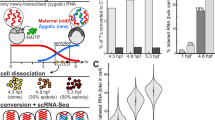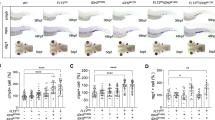Abstract
Aim:
To investigate the embryotoxicity of dihydroartemisinin (DHA), the main active metabolite of artemisinin, in zebrafish, and explore the corresponding mechanisms.
Methods:
The embryos of wild type and TG (flk1:GFP) transgenic zebrafish were exposed to DHA. Developmental phenotypes of the embryos were observed. Development of blood vessels was directly observed in living embryos of TG (flk1:GFP) transgenic zebrafish under fluorescence microscope. The expression of angiogenesis marker genes vegfa, flk1, and flt1 in the embryos was detected using real-time PCR and RNA in situ hybridization assays.
Results:
Exposure to DHA (1–10 mg/L) dose-dependently caused abnormal zebrafish embryonic phenotypes in the early developmental stage. Furthermore, exposure to DHA (10 mg/L) resulted in more pronounced embryonic angiogenesis in TG (flk1:GFP) zebrafish line. Exposure to DHA (10 mg/L) significantly increased the mRNA expression of vegfa, flk1, and flt1 in the embryos. Knockdown of the flk1 protein partially blocked the effects of DHA on embryogenesis.
Conclusion:
DHA causes abnormal embryonic phenotypes and promotes angiogenesis in zebrafish early embryonic development, demonstrating the potential embryotoxicity of DHA.
Similar content being viewed by others
Log in or create a free account to read this content
Gain free access to this article, as well as selected content from this journal and more on nature.com
or
References
Cui L, Su XZ . Discovery, mechanisms of action and combination therapy of artemisinin. Expert Rev Anti Infect Ther 2009; 7: 999–1013.
Klayman DL . Qinghaosu (artemisinin): an antimalarial drug from China. Science 1985; 228: 1049–55.
Chen T, Li M, Zhang R, Wang H . Dihydroartemisinin induces apoptosis and sensitizes human ovarian cancer cells to carboplatin therapy. J Cell Mol Med 2009; 13: 1358–70.
Firestone GL, Sundar SN . Anticancer activities of artemisinin and its bioactive derivatives. Expert Rev Mol Med 2009; 11: e32.
Nakase I, Lai H, Singh NP, Sasaki T . Anticancer properties of artemisinin derivatives and their targeted delivery by transferrin conjugation. Int J Pharm 2008; 354: 28–33.
Ba Q, Zhou N, Duan J, Chen T, Hao M, Yang X, et al. Dihydroartemisinin exerts Its anticancer activity through depleting cellular Iron via transferrin receptor-1. PLoS One 2012; 7: e42703.
Dell'Eva R, Pfeffer U, Vene R, Anfosso L, Forlani A, Albini A, et al. Inhibition of angiogenesis in vivo and growth of Kaposi's sarcoma xenograft tumors by the anti-malarial artesunate. Biochem Pharmacol 2004; 68: 2359–66.
Berger TG, Dieckmann D, Efferth T, Schultz ES, Funk JO, Baur A, et al. Artesunate in the treatment of metastatic uveal melanoma — first experiences. Oncol Rep 2005; 14: 1599–603.
Zhang ZY, Yu SQ, Miao LY, Huang XY, Zhang XP, Zhu YP, et al. Artesunate combined with vinorelbine plus cisplatin in treatment of advanced non-small cell lung cancer: a randomized controlled trial. Zhong Xi Yi Jie He Xue Bao 2008; 6: 134–8. Chinese.
Efferth T, Kaina B . Toxicity of the antimalarial artemisinin and its dervatives. Crit Rev Toxicol 2010; 40: 405–21.
Meshnick SR . Artemisinin: mechanisms of action, resistance and toxicity. Int J Parasitol 2002; 32: 1655–60.
Wartenberg M, Wolf S, Budde P, Grunheck F, Acker H, Hescheler J, et al. The antimalaria agent artemisinin exerts antiangiogenic effects in mouse embryonic stem cell-derived embryoid bodies. Lab Invest 2003; 83: 1647–55.
Longo M, Zanoncelli S, Torre PD, Riflettuto M, Cocco F, Pesenti M, et al. In vivo and in vitro investigations of the effects of the antimalarial drug dihydroartemisinin (DHA) on rat embryos. Reprod Toxicol 2006; 22: 797–810.
Clark RL . Embryotoxicity of the artemisinin antimalarials and potential consequences for use in women in the first trimester. Reprod Toxicol 2009; 28: 285–96.
Clark RL, Arima A, Makori N, Nakata Y, Bernard F, Gristwood W, et al. Artesunate: developmental toxicity and toxicokinetics in monkeys. Birth Defects Res B Dev Reprod Toxicol 2008; 83: 418–34.
Clark RL, White TE, S AC, Gaunt I, Winstanley P, Ward SA . Developmental toxicity of artesunate and an artesunate combination in the rat and rabbit. Birth Defects Res B Dev Reprod Toxicol 2004; 71: 380–94.
Longo M, Zanoncelli S, Della Torre P, Rosa F, Giusti A, Colombo P, et al. Investigations of the effects of the antimalarial drug dihydroartemisinin (DHA) using the Frog Embryo Teratogenesis Assay-Xenopus (FETAX). Reprod Toxicol 2008; 25: 433–41.
Liang D, Chang JR, Chin AJ, Smith A, Kelly C, Weinberg ES, et al. The role of vascular endothelial growth factor (VEGF) in vasculogenesis, angiogenesis, and hematopoiesis in zebrafish development. Mech Dev 2001; 108: 29–43.
Kimmel CB, Ballard WW, Kimmel SR, Ullmann B, Schilling TF . Stages of embryonic development of the zebrafish. Dev Dyn 1995; 203: 253–310.
Bennett CM, Kanki JP, Rhodes J, Liu TX, Paw BH, Kieran MW, et al. Myelopoiesis in the zebrafish, Danio rerio. Blood 2001; 98: 643–51.
Rottbauer W, Just S, Wessels G, Trano N, Most P, Katus HA, et al. VEGF-PLCgamma1 pathway controls cardiac contractility in the embryonic heart. Genes Dev 2005; 19: 1624–34.
Ferrara N, Keyt B . Vascular endothelial growth factor: basic biology and clinical implications. EXS 1997; 79: 209–32.
Ho QT, Kuo CJ . Vascular endothelial growth factor: biology and therapeutic applications. Int J Biochem Cell Biol 2007; 39: 1349–57.
Wang J, Zhang B, Guo Y, Li G, Xie Q, Zhu B, et al. Artemisinin inhibits tumor lymphangiogenesis by suppression of vascular endothelial growth factor C. Pharmacology 2008; 82: 148–55.
Goishi K, Klagsbrun M . Vascular endothelial growth factor and its receptors in embryonic zebrafish blood vessel development. Curr Top Dev Biol 2004; 62: 127–52.
He Y, Fan J, Lin H, Yang X, Ye Y, Liang L, et al. The anti-malaria agent artesunate inhibits expression of vascular endothelial growth factor and hypoxia-inducible factor-1alpha in human rheumatoid arthritis fibroblast-like synoviocyte. Rheumatol Int 2011; 31: 53–60.
Lee J, Zhou HJ, Wu XH . Dihydroartemisinin downregulates vascular endothelial growth factor expression and induces apoptosis in chronic myeloid leukemia K562 cells. Cancer Chemother Pharmacol 2006; 57: 213–20.
Zhou HJ, Wang WQ, Wu GD, Lee J, Li A . Artesunate inhibits angiogenesis and downregulates vascular endothelial growth factor expression in chronic myeloid leukemia K562 cells. Vascul Pharmacol 2007; 47: 131–8.
Acknowledgements
We thank Dr Ting-xi LIU (Institute of Health Sciences, Shanghai Institutes for Biological Sciences, Chinese Academy of Sciences) for the kind gift of the TG (flk1: GFP) transgenic zebrafish line. This study was supported by grants from the Ministry of Science and Technology of China (2012BAK01B00, 2011BAK10B00, and 2009CB919000), the National Natural Science Foundation (81125020, 91029715, 31070680, 31101261, 81242002, and 31200569), the Science and Technology Commission of Shanghai Municipality (12XD1407000, 12431900500, and 10391902100), Xuhui Central Hospital (CRC2011001 and CRC2011004), Director Foundation (20090101), and the Key Labortory of Food Safety Research of Institute for Nutritional Sciences, Shanghai Institutes for Biological Sciences, Chinese Academy of Sciences.
Author information
Authors and Affiliations
Corresponding author
Rights and permissions
About this article
Cite this article
Ba, Q., Duan, J., Tian, Jq. et al. Dihydroartemisinin promotes angiogenesis during the early embryonic development of zebrafish. Acta Pharmacol Sin 34, 1101–1107 (2013). https://doi.org/10.1038/aps.2013.48
Received:
Accepted:
Published:
Issue date:
DOI: https://doi.org/10.1038/aps.2013.48



